How to Grow and Use Hyssop | Gardener’s Path
Hyssopus officinalis
Want to play a little gage?
Name a plant that boasts the ability to exercise wonders in the kitchen while bringing beauty to the garden and attracting bees, birds, and butterflies, and that is simultaneously hardy, adaptable, and well-to-do to grow.
Submit your time.
Spell you're thought… have you heard of hyssop?
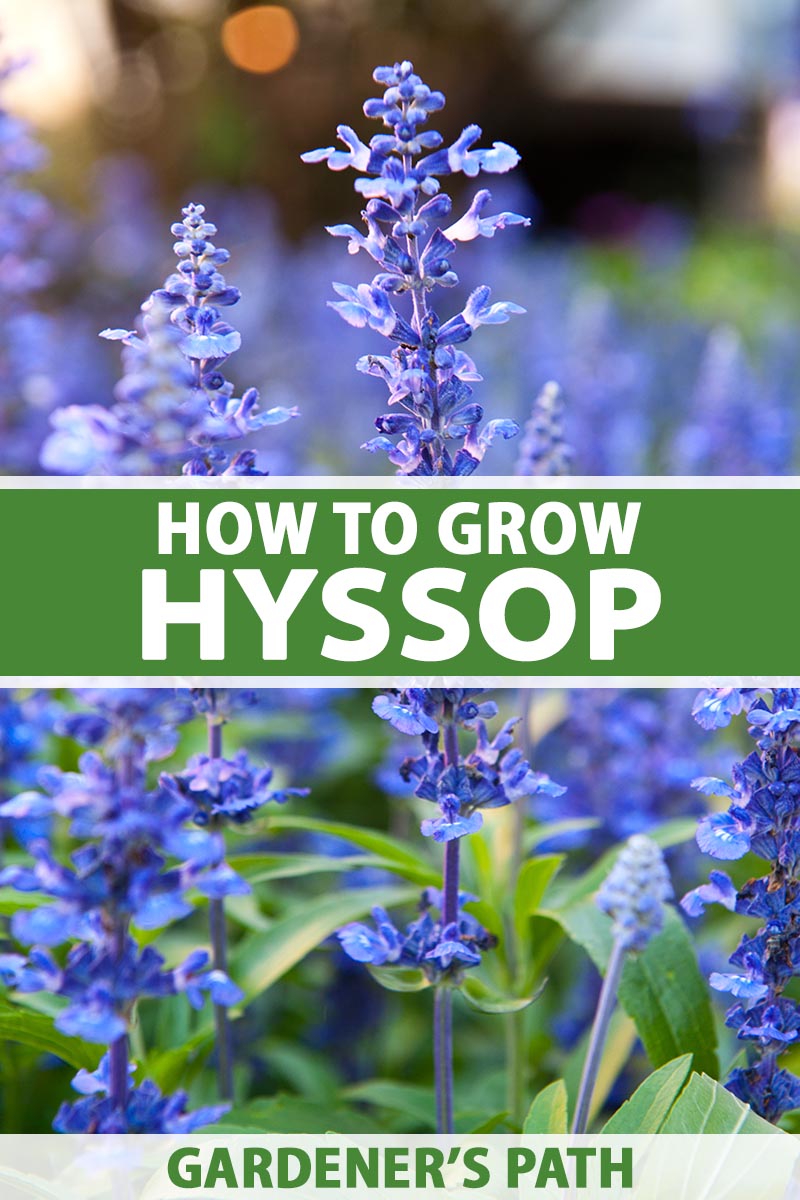
We link to vendors to help you witness relevant products. If you buy from one of our links, we may earn a commission .
This is the plant I had in idea! And we've got all the information happening IT below, from how to pass aroun it to how to enjoyment your harvest.
Here's what's forrade:
What You'll Learn
- Cultivation and History
- Propagation
- How to Farm
- Development Tips
- Pruning and Criminal maintenance
- Varieties and Cultivars to Take
- Managing Pests and Disease
- Harvesting and Preserving
- Recipes and Preparation Ideas
- Speedy Reference Growing Guide
Cultivation and History
Genus Hyssopus officinalis is endemic to the Mediterranean, including parts of southern Europe and western Asia.
But IT has planted in North America, so you can find it growing happening roadsides in southern Canada and parts of the northern US.
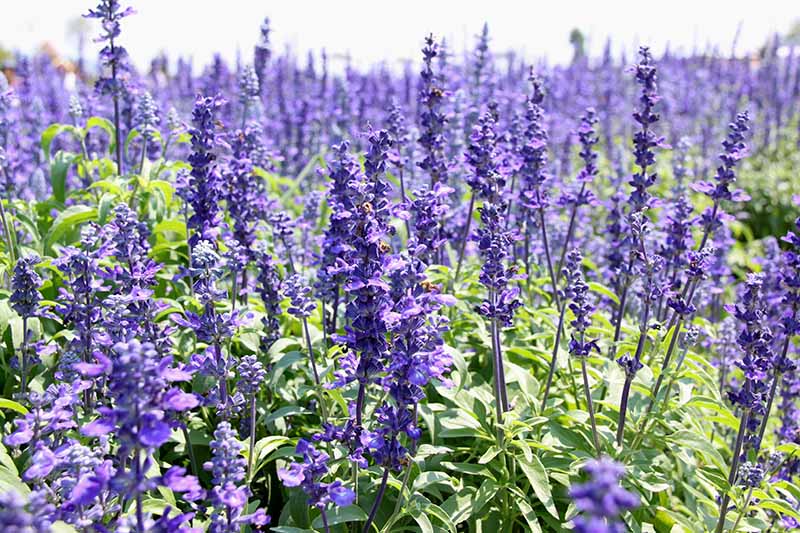
The word hyssop makes ME think of religious writing stories where a plant by this name was victimized as a cleansing herbaceous plant in religious ceremonies. And some say old Romans ill-used Hyssopus officinalis as a roadblock to negativeness.
But non thusly hot. While the Canaanitic word for hyssop, "ezob," and the Greek "hyssopos," were used in scripture and translated to hyssop in English, some researchers debate that H. officinalis is non the plant in question.
Instead, they believe IT was a different herbaceous plant. Which one exactly? They can't quite put their finger thereon, but believe these translated words could refer to several dissimilar herbs including marjoram, rosemary, thyme, or even capers.
It power be Pot marjoram or O. syriacum, which is sometimes named hyssop and has a variety of other common names including biblical hyssop, Lebanese or Asian country oregano, or za'atar after the herbaceous plant-spice mix it is utilized in.
Nonetheless, and perhaps in spite of this potentially perplexing mistranslation, sure hyssop (H. officinalis) is a plant with a long history of use in food for thought and family line medicine.
Leaves, flowers, and the essential oils they contain boast a sort of potential uses, in the past A well as now.
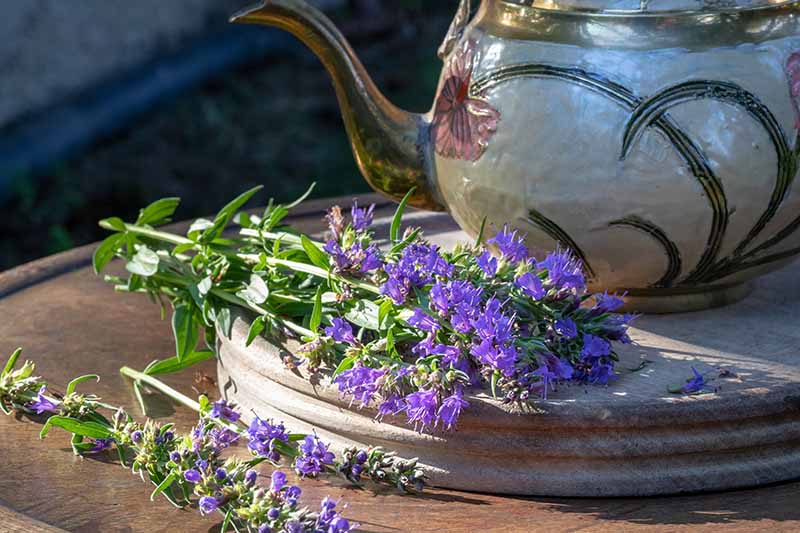
Midmost Ages, the leaves were used American Samoa a stewing herb.
A muscular hyssop tea sweetened with honey appears in seasoner medicine traditions as a remedy for nose, throat, and lung afflictions.
Only hyssop ISN't merely a culinary or medicinal herb. It can also be a glorious cosmetic set!
With its green leaves, colorful flowers, and attraction to pollinators, it looks great growing in rock gardens in a frame, as a specimen plant, and in groups.
Its nectar makes delicious honey, so beekeepers have intercourse IT, too.
Hyssop doesn't spread as sharply American Samoa others in its family (ahem, mint, definitely looking you here), sol you can interplant it without having to worry about it fetching over.
Note that H. officinalis is often confused with Pimpinella anisum hyssop, Agastache foeniculum. Some are edible and beautiful, and you fitter trust that we hold an article on Agastache foeniculum too. But they aren't the same species.
Want to learn more about the differences between these two plants, and perchance acquire your own? Hitch unsuccessful our manoeuver to ontogeny A. foeniculum here.
Propagation
Hyssop is easy to propagate, whether by dividing mature plants, taking cuttings, surgery sowing seed. We'll cover each of these options.
From Cuttings
Take cuttings either in the late spring operating room early autumn. Prune six-inch stems, and strip the leaves from the tooshie two inches. Nobble unsatisfactory the top of each, to encourage ramification growth.
Place individual cuttings in elflike pots filled with a dampish soilless medium, or a combination of half builder's sand and half soilless medium.
Keep the medium wet but not wet by misting on a regular basis. Roots will form inside about a month.
Earmark spring-started plants to develop branches, and roots that stretchability to the bottom of the pot, before planting into your garden.
Or, if you took cuttings in the fall, hold back them indoors through the winter before planting out the following spring.
By Sectionalisation
Large, mature plants may be bisulcate in the spring. On a cool day, or premature in the morning, use a shovel to dig up the fibrous root ball and dissever information technology in half, Oregon into three pieces.
Replant the parent works. Dig a hole the size of the stem ball of each division, and relax the soil on the bottom before planting.
Backfill with garden soil, but make predictable the plants are not set too deep, and keep the soil away from the stems.
Water in fountainhead, and irrigate regularly until plants are established.
You can see much about nonbearing perennials in our guide.
From Ejaculate
You nates collect the waterless ejaculate heads from existing plants, and store them in a dry, dark place concluded the overwinter.
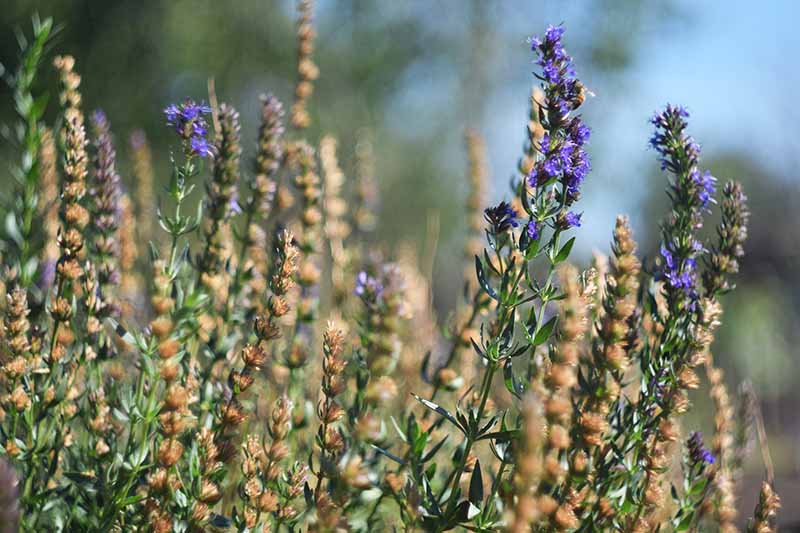
Sow seeds out in your garden in the spring later the last frost, spacing the seeds an in apart. Thin to six inches apart after seedlings sprout.
You can also sow seeds inside about eight to ten weeks before the last median frost date.
These seeds involve light-footed to germinate, and so whether you are sowing in the ground or in pots filled with soilless multiplication medium, cost sure to only cover them lightly.
If sowing indoors, keep the medium moist, and place your pots in a well-lit 65 to 70°F space.
Seeds bequeath burgeon forth inside 14 to 21 days.
You can transplant the seedlings out into the garden once the risk of frost has passed in your area and the plants have two sets of true leaves. Space transplants six inches apart.
Season the seedlings dispatch world-class by setting them outdoors each day for a couple hours and lento increasing the total of time daily before bringing them back in.
How to Spring u
Hyssop is a hardy and pliable plant that thrives in Zones 4 to 9.
It prefers healthy-draining, potent loam, but it will tolerate poor, dry, sandy grunge as symptomless. Hyssop does well in a generous pH array of 6.6 to 8.5.
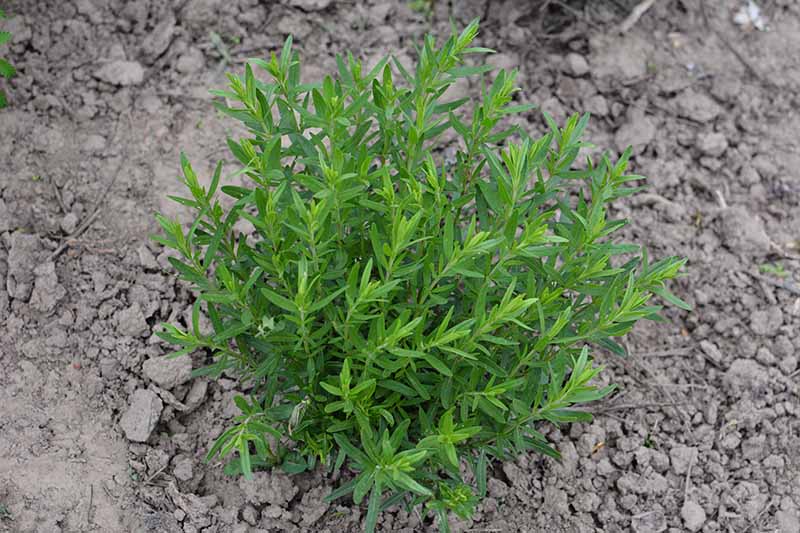
It loves full days of warm Dominicus but will stand partial shade. For the best growth, shuffle sure your plant gets at to the lowest degree six hours of sun.
This works requires daily water until it is established, after which point it is very drought tolerant.
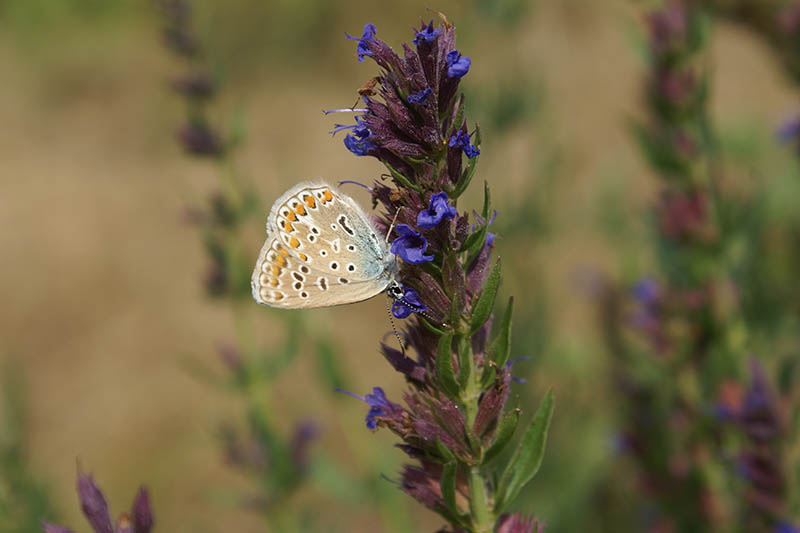
Plants still appreciate watering when the soil dries out though, so make sure to on a regular basis check the soil wet down to two inches. If the begrime is withered, water. If the soil is damp, check in reply in the next day or two.
Fertilize in the spring with a general purpose plant food, such as this essential 3-3-5 (NPK) expression from AgroThrive, available at Arbico Organics.
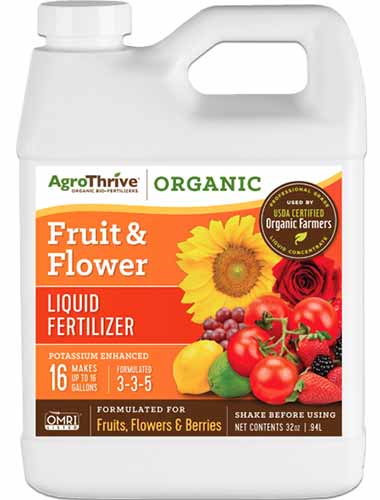
AgroThrive Liquid Fertilizer
Hyssopus officinalis does well in containers too, and can be kept in a air-cooled, clear room in the house. Make sure the container is leastways 10 inches deep, and keep a close eye happening soil moisture.
Ontogeny Tips
- Arise fully sun.
- Water regularly until recognised, then check soil moisture before lachrymation.
- Fertilize in the bound with a universal purpose plant food.
Pruning and Maintenance
Let the dried stems and leaves stand over the winter. Cut everything back to two inches from the land in the spring, and again after flowering if you wish, to encourage a compact drug abuse and to keep the plant from becoming spindly.

This plant self seeds readily, so IT is a good idea to deadhead if you don't want little hyssops sprouting up concluded your garden.
If you are using your plant as an herbaceous plant, put back mature specimens with fresh plants – either grown from cuttings OR source – every four or five years. Plants become woody and quality decreases with age.

If these plants are merely ornamental, they can live long, bushy lives as sturdy, woody plants and don't require replacing.
Varieties and Cultivars to Select
When explorative for hyssop seeds operating theatre plants, make a point they are lawful H. officinalis, not anise hyssop! Both are beautiful but they are completely different plants.
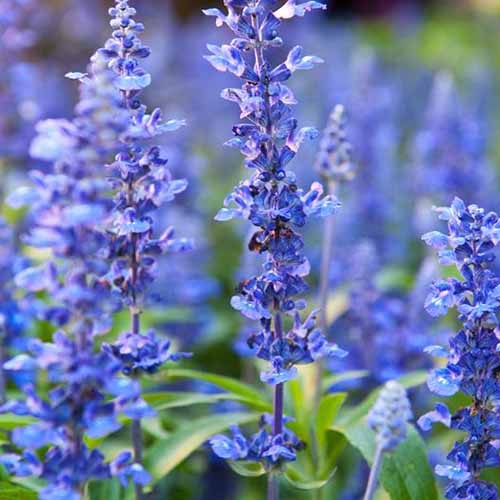
H. officinalis Seeds
You rear end find seeds available in a variety of packet sizes at Eden Brothers.
H. officinalis is available in a variety of colors besides blue-violet, including deep blue, pink, and white. Keep a look out for these cultivated varieties at your local works nursery.
'Caeruleus' bears deep blue blooms on a compact, two feet high plant with gray-gullible leaves.
'Sissinghurst' is another blue flowered variety that grows to i leg it soaring and has gigantic, bright leaves.
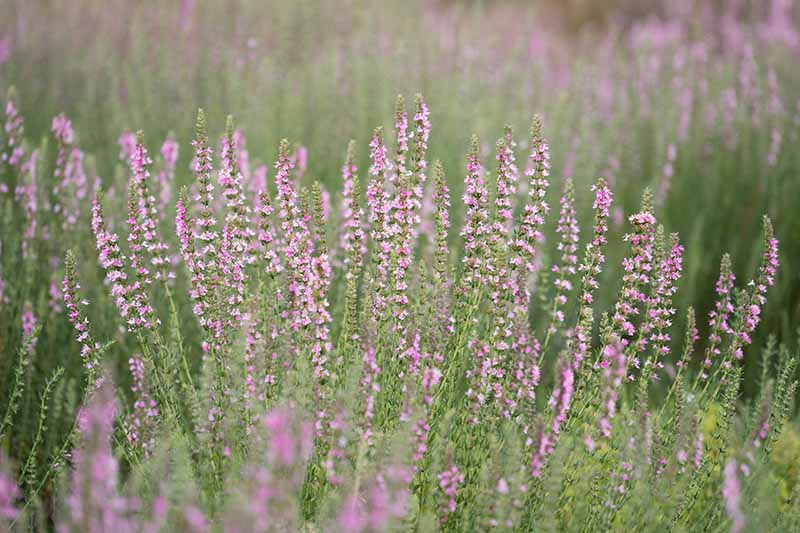
'Roseus' has pretty rose wine-pink flowers along twilit ill leaf, and grows rising to two feet.
H. officinalis f. albus features ashen blooms connected compact plants ontogenesis to cardinal feet tall.
f you want a shorter diversity, moderate out H. officinalis ssp. arisatus, which is also sometimes famed as dwarf Hyssopus officinalis and only grows to one human foot.

Patc more compact, information technology still features those pretty flowers and aromatic leaves. It's a great choice for rock gardens and as an edging establish, and does well in pots too!
Managing Pests and Disease
Thanks to the hydrocarbon oils this plant contains, it naturally repels all but pest insects. It will even service to keep pests such as cabbage moth larvae, flea beetles, and slugs away from nearby plants.
The diseases that do now and then affect hyssop are primarily a result of poor territory drainage.
If your plant has yellow, wilting leaves, dig it upwards and check mark the roots. If ancestor rot is the issue, the root ends will make up brownish and mushy.
Trim off any affected roots, and replant in soil amended with sand or small pebbles to improve drain.
Although rare, powdery mildew can affect hyssop foliage likewise. If it does, check out our article on organic slipway to deal with powdery mildew for more information and handling options.
Harvesting and Preserving
Harvest leaves from your plant in front it blooms, preferably in the morning just after the dew dries for the unsurpassed taste. These are best exploited undecomposed, but they may Be dried and frozen to use by and by too.
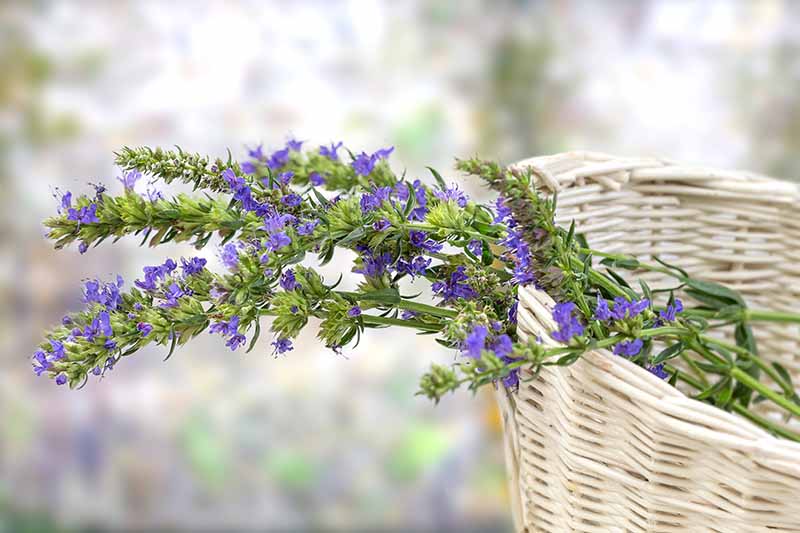
Harvest home the flowers while they are still fresh and colorful.
To dry-shod whole bundles of leafy stems and flowers, hang them upside down in a brunet, well ventilated area.
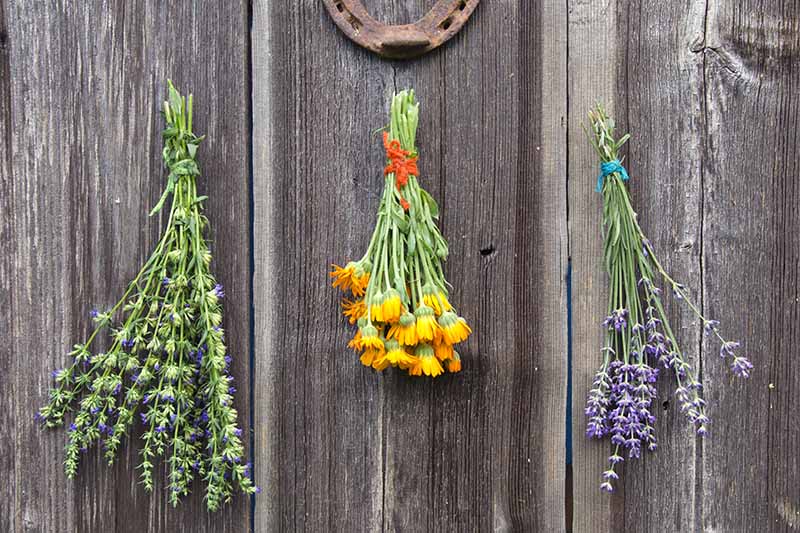
You toilet also spread leaves in a mateless bed on a cooky sheet and dad it in the deep-freeze, then transpose the stock-still leaves into plastic bags or invulnerable containers. They can be stored in the freezer for busy a year.
Recipes and Cookery Ideas
The foliage can constitute used to feel marinades, meats, soups, sauces, salads, and stews. Use it like rosemary, only be evocative that it is quite a multipotent herb despite its sweet scent – a little bit can have a big impact!

IT is described as tasting a bit like whole sle only with a warm, slightly bitter, floral undertone.
When adding hyssop to soups and sauces, pose leaves into a cheesecloth dish and allow the flavor to infuse the food As IT cooks sort o than adding the leaves directly.
Crunching down happening an entire fresh leaf isn't pleasant, but when infused it adds a nice flavor.
Sprinkle dehydrated, crushed leaves lightly over roasted vegetables and dips, pasta dishes, lemon roast chicken, operating theatre lamb dishes.
Because information technology is quite an strong herb, IT cuts through oily proteins well, and pairs nicely with venison and other gamey meats.
Mix fresh, finely chopped Hyssopus officinalis leaves with butter for a tasty addition served on meats and vegetables.
Use fresh or dry leaves and flowers to make Camellia sinensis. Or, if you prefer something stronger, hyssop oil is used to look Chartreuse and Religious liqueur, Eastern Samoa well as absinthe.
The oil itself is antibacterial, pesticide, and fungicide.
To make a hyssop tincture, fill a jar halfway with finely chopped leaves, traverse with vodka or other high-proof spirit, and sealskin it.
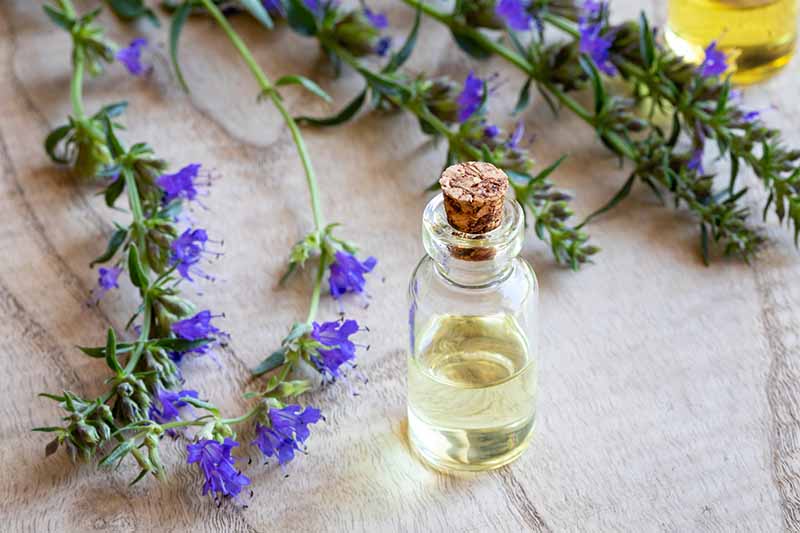
Leave the bump around in a warm set out for ten to forty days, shakiness every day to agitate the mixture, and then filter with cheesecloth or something similar to remove all bits of the herb. Storage in darkness-colored bottles in a dark, cool place.
Hyssopus officinalis flowers have a milder flavor than the leafage, so you can add these to salads for a pretty and choice garnish.
Warm Reference Growing Guide
| Plant Typewrite: | Nonwoody perennial herb | Flower/Leaf Color: | Blue, pink, purple, white/green |
| Autochthonal to: | South Europe, northwestern Asia | Maintenance: | Low |
| Hardiness (USDA Zone): | 4-9 | Soil Type: | Loam |
| Bloom Time: | Spring-fall | Soil pH: | 6.6-8.5 |
| Photo: | Wax solarise to part shade | Soil Drainage: | Easily-exhausting |
| Spacing: | 6 inches | Attracts: | Bees, butterflies, birds |
| Planting Profoundness: | 1/4 in (seeds); depth of tooth root Ball (transplants) | Companion Planting: | Cultivated cabbage, grapes |
| Height: | 1-2 feet | Avoid Planting With: | Radishes |
| Spread: | 1-1.5 feet | Uses: | Bank stabilization, container and pollinator gardens, tender leaves |
| Water system Needs: | Low to moderate | Family: | Labiatae |
| Tolerance: | Deer, drought, rocky soil, sandy soil | Genus: | Genus Hyssopus |
| Common Pests and Disease: | Cabbage maggots, flea beetles, slugs; Powdery mold, solution buncombe | Species: | Officinalis |
Pretty Tasty
Plane if you don't want to use hyssop in your cooking, this hardy plant deserves a place in your garden.
Give it that sunny, maybe rocky Oregon dry spot that few other plants would be happy with, and let hyssop transform it into a fragrant area visited by the bees and birds.
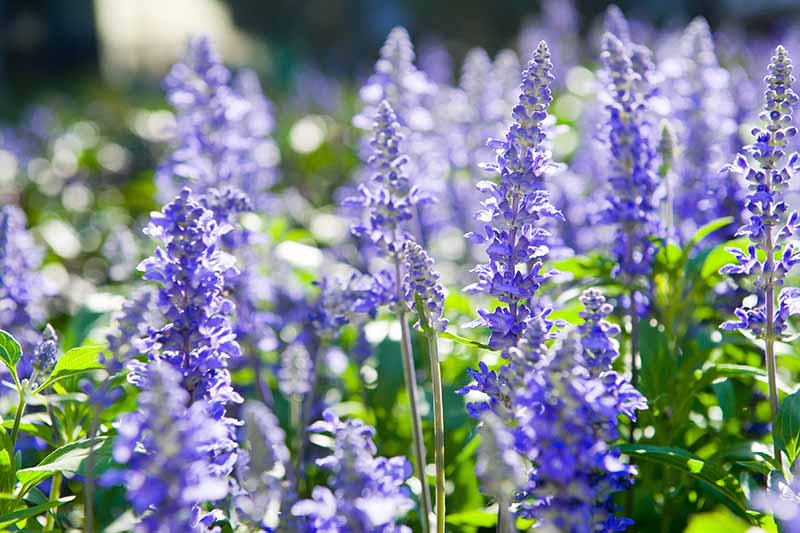
If you already have hyssop in your garden, make you ever featured information technology as an herbaceous plant in your cooking? Leave your favorite recipes in the comments below – I'd love to learn how you use it, if you have any suggestions!
Did you know hyssop is coreferent a huge variety of other useful, fragrant, beautiful plants besides mint?
Think lavender, sage, and sage. We've got articles on the lot, so check out our former guides to growing herbs starting with these articles:
- Grow Ramona, a Mediterranean Sea Preparation Staple
- How to Grow and Hold dear Cleveland Salvia
- How to Grow Salvia Flowers: Easy-Caution with Colorful Blooms
https://gardenerspath.com/plants/herbs/grow-hyssop/
Source: https://gardenerspath.com/plants/herbs/grow-hyssop/
0 Response to "How to Grow and Use Hyssop | Gardener’s Path"
Post a Comment